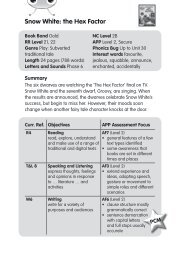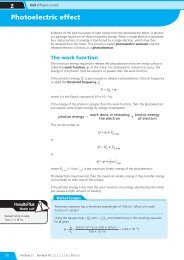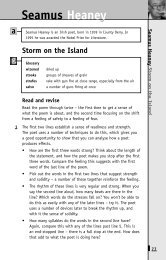Unit 1 Module 3 The Periodic Table - Pearson Schools
Unit 1 Module 3 The Periodic Table - Pearson Schools
Unit 1 Module 3 The Periodic Table - Pearson Schools
Create successful ePaper yourself
Turn your PDF publications into a flip-book with our unique Google optimized e-Paper software.
Glossary<br />
periodicity A regular periodic variation of properties of<br />
elements with atomic number and position in the <strong>Periodic</strong><br />
<strong>Table</strong>.<br />
permanent dipole A small charge difference across a bond<br />
resulting from a difference in electronegativities of the<br />
bonded atoms.<br />
permanant dipole–dipole force An attractive force between<br />
permanent dipoles in neighbouring polar molecules.<br />
pi-bond (p-bond) <strong>The</strong> reactive part of a double bond<br />
formed above and below the plane of the bonded atoms by<br />
sideways overlap of p-orbitals.<br />
polar covalent bond A bond with a permanent dipole.<br />
polar molecule A molecule with an overall dipole, taking into<br />
account any dipoles across bonds.<br />
polymer A long molecular chain built up from monomer<br />
units.<br />
precipitation reaction <strong>The</strong> formation of a solid from a<br />
solution during a chemical reaction. Precipitates are often<br />
formed when two aqueous solutions are mixed together.<br />
principal quantum number, n A number representing the<br />
relative overall energy of each orbital, which increases with<br />
distance from the nucleus. <strong>The</strong> sets of orbitals with the same<br />
n value are referred to as electron shells or energy levels.<br />
propagation <strong>The</strong> two repeated steps in radical substitution<br />
that build up the products in a chain reaction.<br />
radical A species with an unpaired electron.<br />
radical substitution A type of substitution reaction in which<br />
a radical replaces a different atom or group of atoms.<br />
rate of reaction <strong>The</strong> change in concentration of a reactant<br />
or a product in a given time.<br />
redox reaction A reaction in which both reduction and<br />
oxidation take place.<br />
reducing agent A reagent that reduces (adds electrons to)<br />
another species.<br />
reduction Gain of electrons or a decrease in oxidation<br />
number.<br />
reflux <strong>The</strong> continual boiling and condensing of a reaction<br />
mixture to ensure that the reaction takes place without the<br />
contents of the flask boiling dry.<br />
relative atomic mass, A r <strong>The</strong> weighted mean mass of an<br />
atom of an element compared with one-twelfth of the mass<br />
of an atom of carbon-12.<br />
relative formula mass <strong>The</strong> weighted mean mass of a<br />
formula unit compared with one-twelfth of the mass of an<br />
atom of carbon-12.<br />
relative isotopic mass <strong>The</strong> mass of an atom of an isotope<br />
compared with one-twelfth of the mass of an atom of<br />
carbon-12.<br />
relative molecular mass, M r <strong>The</strong> weighted mean mass of a<br />
molecule compared with one-twelfth of the mass of an<br />
atom of carbon-12.<br />
repeat unit A specific arrangement of atoms that occurs in<br />
the structure over and over again. Repeat units are included<br />
in brackets, outside of which is the symbol n.<br />
salt A chemical compound formed from an acid, when a H +<br />
ion from the acid has been replaced by a metal ion or<br />
another positive ion, such as the ammonium ion, NH 4+ .<br />
saturated hydrocarbon A hydrocarbon with single bonds<br />
only.<br />
shell A group of atomic orbitals with the same principal<br />
quantum number, n. Also known as a main energy level.<br />
simple molecular lattice A three-dimensional structure of<br />
molecules, bonded together by weak intermolecular forces.<br />
skeletal formula A simplified organic formula, with hydrogen<br />
atoms removed from alkyl chains, leaving just a carbon<br />
skeleton and associated functional groups.<br />
species Any type of particle that takes part in a chemical<br />
reaction.<br />
specific heat capacity, c <strong>The</strong> energy required to raise the<br />
temperature of 1 g of a substance by 1 °C.<br />
spectator ions Ions that are present but take no part in a<br />
chemical reaction.<br />
standard conditions A pressure of 100 kPa (1 atmosphere),<br />
a stated temperature, usually 298 K (25 °C), and a<br />
concentration of 1 mol dm –3 (for reactions with aqueous<br />
solutions).<br />
standard enthalpies see enthalpy.<br />
standard solution A solution of known concentration.<br />
Standard solutions are normally used in titrations to<br />
determine unknown information about another substance.<br />
standard state <strong>The</strong> physical state of a substance under the<br />
standard conditions of 100 kPa (1 atmosphere) and 298 K<br />
(25 °C).<br />
stereoisomers Compounds with the same structural formula<br />
but with a different arrangement of the atoms in space.<br />
stoichiometry <strong>The</strong> molar relationship between the relative<br />
quantities of substances taking part in a reaction.<br />
stratosphere <strong>The</strong> second layer of the Earth’s atmosphere,<br />
containing the ‘ozone layer’, about 10 km to 50 km above<br />
the Earth’s surface.<br />
structural formula A formula showing the minimal detail for<br />
the arrangement of atoms in a molecule.<br />
structural isomers Molecules with the same molecular<br />
formula but with different structural arrangements of atoms.<br />
sub-shell A group of the same type of atomic orbitals (s, p,<br />
d or f) within a shell.<br />
271<br />
935 chemistry.endmatter.indd 271 13/11/07 1:24:31 pm
















